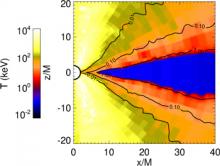
Abstract
We describe results from a new technique for the prediction of complete, self-consistent X-ray spectra from three-dimensional general relativistic magnetohydrodynamic (GRMHD) simulations of black hole accretion flows. Density and cooling rate data from a harm3d GRMHD simulation are post-processed by an improved version of the Monte Carlo radiation transport code pandurata (in the corona) and the Feautrier solver ptransx (in the disk), with xstar subroutines. The codes are run in a sequential, iterative fashion to achieve globally energy-conserving and self-consistent radiation fields, temperature maps, and photoionization equilibria. The output is the X-ray spectrum as seen by a distant observer, including features, such as the Fe Kα emission line and corresponding K-edge absorption trough, due to disk reprocessing of coronal power. For the example cases we consider—a non-rotating 10 M ⊙ black hole with solar abundances, accreting at 0.01, 0.03, 0.1, or 0.3 Eddington—we find spectra resembling actual observations of stellar-mass black holes in the soft or steep power-law state: broad thermal peaks (at 1–3 keV), steep power laws extending to high energy (Γ = 2.7–4.5), and prominent, asymmetric Fe Kα emission lines with equivalent widths in the range 40–400 eV (larger EW at lower accretion rates). By starting with simulation data, we obviate the need for parameterized descriptions of the accretion flow geometry—no a priori specification of the corona's shape or flux, or the disk temperature or density, etc., is needed. Instead, we apply the relevant physical principles to simulation output using appropriate numerical techniques; this procedure allows us to calculate inclination-dependent spectra after choosing only a small number of physically meaningful parameters: black hole mass and spin, accretion rate, and elemental abundances.